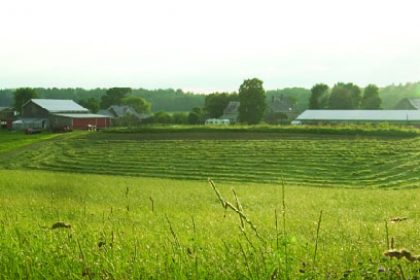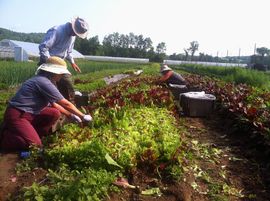
As we look towards 2016, we are sharing a 3-part series featuring updates on the food systems work going on in each of the New England states.
Maine
Overall, there are many great trends to report in Maine related to food, farming and fisheries in 2015!
Institutional Purchasing
Maine’s colleges and institutions have been focusing on food in a big way in 2015. For example, the University of Maine System has set a goal of purchasing and serving 20% local food by 2020. Six colleges in Maine – Colby College, Maine College of Art, Maine Maritime Academy, Southern Maine Community College, Thomas College, University of New England – have committed to shifting their purchasing of whitefish to be 100% Gulf of Maine Responsibly Harvested® by 2020. Throughout the fall 2015 semester, all of these schools started serving underloved fish like dogfish, redfish, and pollock in their dining halls, and they are working with the Gulf of Maine Research Institute to educate students about why it’s important. Meanwhile, 2015 saw the official launch of the Maine Farm and Sea Cooperative, the nation’s first farm-to-institution food service cooperative. Maine hospitals have also been making great strides in efforts to serve more locally harvested fish and farm products.
Business Innovations
2015 marked the opening of Unity Food Hub, a center for aggregating, marketing, and distributing Maine foods. UFH is housed in a renovated old grammar school in Unity, Maine, and offers a variety of different farm shares, including workplace and low-income shares. New Roots Cooperative Farm, the state’s first immigrant owned producer cooperative, was formed by Somali Bantu farmers in Lewiston this year. Maine’s Grandy Oats has designed the first solar-powered, net-zero food facility in New England. Maine cheesemakers won 10 awards at the 2015 American Cheese Society Judging and Competition in Providence, RI and Maine’s Department of Agriculture reported a record number of inquiries and applications for permits to sell value-added dairy products.
Supporting Growth
The Maine Food Strategy continues to work on statewide alignment around four identified goal areas: Economic Development, Healthy Food for All, Healthy Maine Environment, and Vibrant Communities, rounding out the year with a Work Session and Network Gathering on December 4. The Conservation Law Foundation launched the Maine Legal Services Food Hub to provide pro bono legal advice to farmers and food producers. A group of forward thinking organizations also hosted the first ever Maine Farmland Access Conference to address the challenges that farmers face in gaining access to farmland, as well as the tools and resources (both existing and imagined) to help improve access.
Addressing Hunger
The USDA announced the first ever Food Insecurity Nutrition Incentive (FINI) grant recipients, providing money to increase low-income access to healthy, local food. Maine Farmland Trust is the primary Maine recipient of these funds and is coordinating the Maine Local Foods Access Network to establish newly-developed Maine Harvest Bucks at local retail stores, farm stands, CSAs, and farmers’ markets with a variety of partners across the state. MFT is focusing particularly on expanding nutrition incentives to retail outlets for the first time ever in Maine, to better increase access to local food, broaden the customer base for farmers and local food retailers, and make local food more mainstream. Good Shepherd Food Bank has acquired what will become a new aggregation and distribution facility in Hampden, allowing them to source more Maine grown food to feed hungry and food insecure residents throughout the state.
Celebrating the Maine Food Movement
MOFGA’s Common Ground Country Fair drew an all-time record number of attendees, topping 60,000 visitors to the Common Ground Education Center in Unity, ME, and the first Russell Libby Scholar Awards were awarded to two Maine students and a farmer. A number of Maine’s leaders in food systems work were recognized with Source Awards, “honoring people and programs moving Maine toward greater sustainability,” and Maine’s notorious 4-season farm pioneer, Eliot Coleman, got a James Beard award.
Policy Progress
2015 was a busy year for Maine’s State Legislature, with dozens of agriculture, fisheries and food related bills making their way through the pipeline. One highlight was the passage of LD 1291 – An Act to Promote Food Self-sufficiency for the People of the State, which aims to grow agricultural jobs and Maine farm sales, and to enable people to grow, process, and preserve food for themselves and their communities. Another success came late in the year when, after immense effort from leaders in all political parties, Maine’s Governor finally announced that he would release bond money approved by voters in 2010 and 2012 that protects farmland, working waterfront, and recreational and hunting land for public use through the Land for Maine’s Future program. On the national front, Maine’s Congresswoman Chellie Pingree introduced an innovative bill to reduce food waste.
Environmental Achievements
Shaping up to be the largest river restoration project in the country to date, the Penobscot River is showing signs of being vital habitat for recovery of fish species of importance to Maine’s recreational and commercial fisheries. Alewives counted at the Milford fish lift tripled from 2014 to 2015 and American shad numbers are also growing exponentially. The shortnose sturgeon, listed endangered for 50 years, has also returned to a portion of the Penobscot River above the Veazie Dam, which was removed in 2013.
Vermont
Vermont’s Farm to Plate food system plan is entering its fifth year of being implemented by the Farm to Plate Network to increase economic development and jobs in the farm and food sector and improve access to healthy local food for all Vermonters. 2015 was a busy year for Vermont Farm to Plate!
The connections between soil regeneration and water quality as the foundation for healthy food were the focus at the 2015 Annual Farm to Plate Gathering held in October. Slow Money Vermont held a series of events to help develop lending, investment, and networking opportunities for investors, entrepreneurs, and service providers. A Health Cross-cutting Team was added to the Farm to Plate Network structure to explore ways to connect food systems development with existing public health initiatives. Vermont’s inaugural Open Farm Week was organized as a collaborative statewide agritourism project by members of the Vermont Farm to Plate Network. A series of on-farm energy case studies were released showcasing energy efficiency savings and renewable energy production. The Food System Educator Professional Learning Community (PLC) was created as a partnership between the Vermont Agency of Education and Farm to Plate to share food system education curriculum among teachers and other educators. The updated Food Security section of the Farm to Plate Strategic Plan was published and food access issues continue to be integrated into efforts across the Farm to Plate Network.
Heading into 2016, the Farm to Plate Network will be exploring farm profitability metrics as production improvements are made to increase the volume and seasonality of local food products and will be exploring what is needed to help producers prepare to sell into wholesale markets for the first time. At the same time, the Network is working with independently owned grocery store owners and distributors to increase the amount of local food sourced and provide access to technical / business assistance to improve local product marketing. As farmers and producers scale up and additional market channels (retail, restaurants, institutions, direct sale) are opened to more Vermont food, a statewide local food consumer demand marketing campaign will kick into gear aimed at increasing purchases, participation and awareness in Vermont’s local food economy.
Stay tuned for the Vermont Farm to Plate Annual Report later in January 2016!





